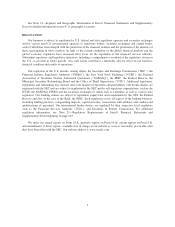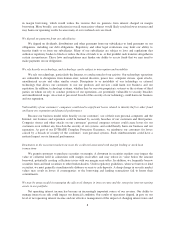eTrade 2008 Annual Report Download - page 16
Download and view the complete annual report
Please find page 16 of the 2008 eTrade annual report below. You can navigate through the pages in the report by either clicking on the pages listed below, or by using the keyword search tool below to find specific information within the annual report.securities has often led to securities class action litigation. Such litigation could result in substantial costs to us
and divert our attention and resources, which could harm our business. As discussed in Note 23—Commitments,
Contingencies and Other Regulatory Matters in Item 8. Financial Statements and Supplementary Data, the
Company is currently a party to litigation related to the decline in the market price of our stock, and such
litigation could occur again in the future. Declines in the market price of our common stock or failure of the
market price to increase could also harm our ability to retain key employees, reduce our access to capital and
otherwise harm our business.
We may need additional funds in the future, which may not be available and which may result in dilution of the
value of our common stock
In the future, we may need to raise additional funds via debt and/or equity instruments, which may not be
available on favorable terms, if at all. If adequate funds are not available on acceptable terms, we may be unable
to fund our plans for the growth of our business. In addition, if funds are available, the issuance of equity
securities could significantly dilute the value of our shares of our common stock and cause the market price of
our common stock to fall.
During the second half of 2008, the global financial markets were in turmoil and the equity and credit
markets experienced extreme volatility, which caused already weak economic conditions to worsen. Continued
turmoil in the global financial markets could further restrict our access to the public equity and debt markets.
In October 2008, we applied to participate in the Troubled Asset Relief Program (“TARP”) Capital
Purchase Program established under the Emergency Economic Stabilization Act of 2008. To date, our application
has not been approved or rejected. If our application is approved, the acceptance of this funding by us would
result in significant dilution to the holders of our common stock as the terms of this program would require us to
issue equity instruments to the federal government. In addition, the approval would likely be conditional upon
additional capital raising activities by us, including possible transactions with existing security holders, which
likely would result in further substantial dilution to the holders of our common stock. We expect that our
participation in the TARP program will require bondholder consent and any additional capital raising activities
may require stockholder approval. No assurance can be given that our TARP application will be approved or that
we will receive bondholder consent or stockholder approval, if required. Recent announcements by the U.S.
Treasury have indicated that there will be changes to the program going forward, and our application may be
approved under a program with different terms than those of the current Capital Purchase Program. If our
application is not approved, customers could view this as a negative assessment of our viability, which could in
turn lead to destabilization and asset and customer attrition.
We have various mechanisms in place that may discourage takeover attempts
Certain provisions of our certificate of incorporation and bylaws may discourage, delay or prevent a third
party from acquiring control of us in a merger, acquisition or similar transaction that a shareholder may consider
favorable. Such provisions include:
• authorization for the issuance of “blank check” preferred stock;
• provision for a classified Board of Directors (“Board”) with staggered, three-year terms;
• the prohibition of cumulative voting in the election of directors;
• a super-majority voting requirement to effect business combinations or certain amendments to our
certificate of incorporation and bylaws;
• limits on the persons who may call special meetings of shareholders;
• the prohibition of shareholder action by written consent; and
• advance notice requirements for nominations to the Board or for proposing matters that can be acted on
by shareholders at shareholder meetings.
13
























